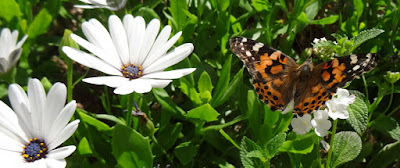The Desert Botanical Gardens in Phoenix was clearly one of our favorite haunts. It was close and we had our choice of virtually any restaurant you could name on the way. Included below is a sampling of the beautiful spring flowers we saw on two separate trips - one with our friends Darlene and Bill and another visit on our own.
Echinocereus coccineus, Scarlet Hedgehog Cactus
Opuntia, Prickly Pear cactus
Opuntia, Prickly Pear cactus
Sphaeralcea ambigua, Globemallow
Opuntia, Prickly Pear cactus
Calliandra eriophylla, Pink Fairy Duster
This little bunny probably nibbled on a different flower every day - talk about variety!
Sylvilagus audubonii, Desert Cottontail
The Fairy Dusters below were in the process of unwinding into their final state. I was able to catch blooms in every stage of development in this single frame.
Calliandra californica, Baja Fairy Duster
Adenium obesum, Desert Rose
The bloom below had to be one of the strangest we had ever seen. It certainly took the prize for "wildest construction."
Passifloraceae, the passion-flower
Passiflora belongs to the Passifloraceae family. There are over 400 species of this extraordinary plant.
Fouquieria splendens, Ocotillo (but also referred to as coachwhip, candlewood, slimwood, desert coral, Jacob's staff, Jacob cactus, and vine cactus)
Adenium obesum, Desert Rose
Zygophyllaceae: Larrea tridentata, Creosote Bush
Someone on the trail asked if I knew where the butterfly pavilion was located. I told them but I thought it was closed. That's when we learned the exhibit had just reopened. We spent quite a while with the delicate creatures floating around us and occasionally posing for a picture or two.
Vanessa cardul, Painted Lady Butterfly
Agraulis vanillae, Gulf Fritillary
Agavaceae, Agave Americana (century plant)
Parkinsonia aculeata, Palo Verde Tree
"The Desert Botanical Garden displays 186 of the 212 known species and varieties in the genus Agave, making this the most prominent agave collection in the United States and perhaps in the world."
The abundant rains covered the Ocotillo with a thick layer of green topped by the delicate red blooms - a far cry from the typical dried out, leafless, spindly look they have throughout most of the summer months.
Wiki: Ocotillo is not a true cactus. For much of the year, the plant appears to be an arrangement of large spiny dead sticks, although closer examination reveals that the stems are partly green. With rainfall, the plant quickly becomes lush with small (2–4 cm), ovate leaves, which may remain for weeks or even months.
We found out there was an effort many years ago to make the gardens into a National Park. Whether that would have been good or not I don't know but with the abundance of specimens, the evening light show and many other programs we think the gardens are a treasure and will certainly be visiting them again whenever we are in the area. If you join the American Horticultural Society (AHS) for $50 (Sustaining Member - admits 2) they have a reciprocal admissions program that allows free admission into botanical gardens across the country.









































No comments:
Post a Comment